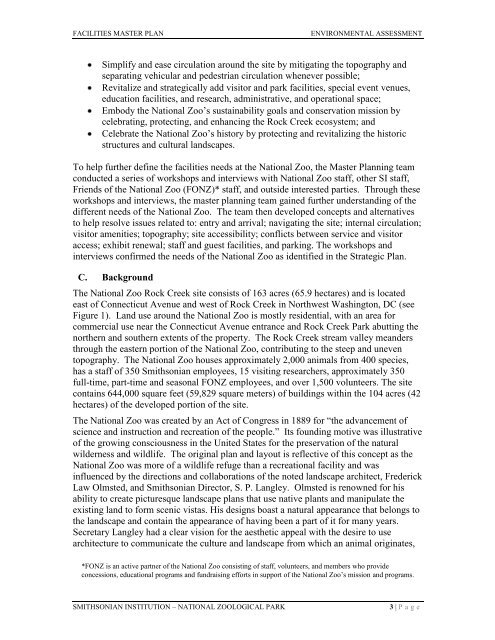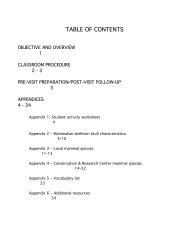facilities renewal master plan - National Zoo - Smithsonian Institution
facilities renewal master plan - National Zoo - Smithsonian Institution
facilities renewal master plan - National Zoo - Smithsonian Institution
Create successful ePaper yourself
Turn your PDF publications into a flip-book with our unique Google optimized e-Paper software.
FACILITIES MASTER PLAN ENVIRONMENTAL ASSESSMENT<br />
Simplify and ease circulation around the site by mitigating the topography and<br />
separating vehicular and pedestrian circulation whenever possible;<br />
Revitalize and strategically add visitor and park <strong>facilities</strong>, special event venues,<br />
education <strong>facilities</strong>, and research, administrative, and operational space;<br />
Embody the <strong>National</strong> <strong>Zoo</strong>’s sustainability goals and conservation mission by<br />
celebrating, protecting, and enhancing the Rock Creek ecosystem; and<br />
Celebrate the <strong>National</strong> <strong>Zoo</strong>’s history by protecting and revitalizing the historic<br />
structures and cultural landscapes.<br />
To help further define the <strong>facilities</strong> needs at the <strong>National</strong> <strong>Zoo</strong>, the Master Planning team<br />
conducted a series of workshops and interviews with <strong>National</strong> <strong>Zoo</strong> staff, other SI staff,<br />
Friends of the <strong>National</strong> <strong>Zoo</strong> (FONZ)* staff, and outside interested parties. Through these<br />
workshops and interviews, the <strong>master</strong> <strong>plan</strong>ning team gained further understanding of the<br />
different needs of the <strong>National</strong> <strong>Zoo</strong>. The team then developed concepts and alternatives<br />
to help resolve issues related to: entry and arrival; navigating the site; internal circulation;<br />
visitor amenities; topography; site accessibility; conflicts between service and visitor<br />
access; exhibit <strong>renewal</strong>; staff and guest <strong>facilities</strong>, and parking. The workshops and<br />
interviews confirmed the needs of the <strong>National</strong> <strong>Zoo</strong> as identified in the Strategic Plan.<br />
C. Background<br />
The <strong>National</strong> <strong>Zoo</strong> Rock Creek site consists of 163 acres (65.9 hectares) and is located<br />
east of Connecticut Avenue and west of Rock Creek in Northwest Washington, DC (see<br />
Figure 1). Land use around the <strong>National</strong> <strong>Zoo</strong> is mostly residential, with an area for<br />
commercial use near the Connecticut Avenue entrance and Rock Creek Park abutting the<br />
northern and southern extents of the property. The Rock Creek stream valley meanders<br />
through the eastern portion of the <strong>National</strong> <strong>Zoo</strong>, contributing to the steep and uneven<br />
topography. The <strong>National</strong> <strong>Zoo</strong> houses approximately 2,000 animals from 400 species,<br />
has a staff of 350 <strong>Smithsonian</strong> employees, 15 visiting researchers, approximately 350<br />
full-time, part-time and seasonal FONZ employees, and over 1,500 volunteers. The site<br />
contains 644,000 square feet (59,829 square meters) of buildings within the 104 acres (42<br />
hectares) of the developed portion of the site.<br />
The <strong>National</strong> <strong>Zoo</strong> was created by an Act of Congress in 1889 for “the advancement of<br />
science and instruction and recreation of the people.” Its founding motive was illustrative<br />
of the growing consciousness in the United States for the preservation of the natural<br />
wilderness and wildlife. The original <strong>plan</strong> and layout is reflective of this concept as the<br />
<strong>National</strong> <strong>Zoo</strong> was more of a wildlife refuge than a recreational facility and was<br />
influenced by the directions and collaborations of the noted landscape architect, Frederick<br />
Law Olmsted, and <strong>Smithsonian</strong> Director, S. P. Langley. Olmsted is renowned for his<br />
ability to create picturesque landscape <strong>plan</strong>s that use native <strong>plan</strong>ts and manipulate the<br />
existing land to form scenic vistas. His designs boast a natural appearance that belongs to<br />
the landscape and contain the appearance of having been a part of it for many years.<br />
Secretary Langley had a clear vision for the aesthetic appeal with the desire to use<br />
architecture to communicate the culture and landscape from which an animal originates,<br />
*FONZ is an active partner of the <strong>National</strong> <strong>Zoo</strong> consisting of staff, volunteers, and members who provide<br />
concessions, educational programs and fundraising efforts in support of the <strong>National</strong> <strong>Zoo</strong>’s mission and programs.<br />
SMITHSONIAN INSTITUTION – NATIONAL ZOOLOGICAL PARK 3 | P a g e

















